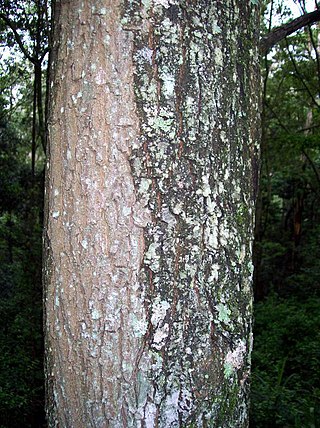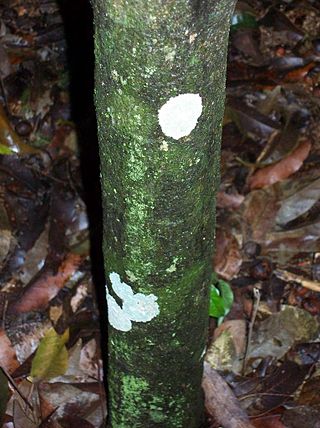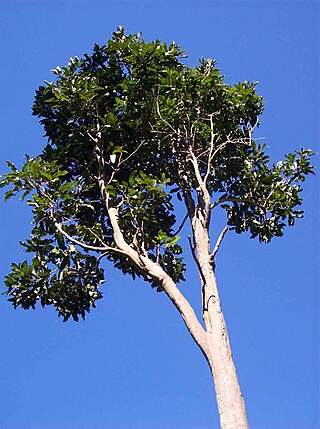
Alyxia ruscifolia, commonly known as the chainfruit or prickly alyxia, is a shrub of high rainfall areas in eastern Australia. The natural range of distribution is from Wollongong in New South Wales to the Wet Tropics and further north to New Guinea.

Auranticarpa rhombifolia is a rainforest tree of eastern Australia. Known as the diamond leaf pittosporum, this tree is planted in many parts of Australia as an ornamental. The white flowers and orange fruit make it a most appealing street or garden tree. Other common names include hollywood, diamond leaf laurel, white myrtle and white holly.

Endiandra pubens is a rainforest tree growing in eastern Australia. The habitat is subtropical rainforest growing near streams in valleys. The range of natural distribution is from the Bellinger River, New South Wales to Bulburin National Park, south west of Gladstone, Queensland.

Piper novae-hollandiae, known as the giant pepper vine, is a common climber growing in rainforests of eastern Australia. It is related to the pepper plant. It grows north from Mount Dromedary in southern New South Wales to tropical Queensland.

Backhousia subargentea is a rare Australian rainforest tree, growing near Mullumbimby in north eastern New South Wales and from Boonah to Imbil in south eastern Queensland.

Claoxylon australe, known as brittlewood is a common rainforest shrub or understorey tree. The habitat is all types of eastern Australian rainforests. The natural range of distribution is from Eden in south eastern New South Wales to Bowen in tropical Queensland.

Croton verreauxii known as the green native cascarilla is a small tree or shrub growing in dry rainforest and rainforest margins in eastern Australia.

Psychotria loniceroides, the hairy psychotria, is a plant native to the forest areas of eastern Australia.

Endiandra discolor is an Australian tree, growing from near Gosford, New South Wales to Tully, Queensland in the tropics. Common names include rose walnut and domatia tree.

Endiandra virens is an Australian tree in the laurel family. Growing from Boorganna Nature Reserve north west of Taree, New South Wales to Kin Kin in Southern Queensland. Common names include White Apple, Plumwood, and New South Wales Walnut.

Daphnandra johnsonii, also known as the Illawarra socketwood, is a rare rainforest tree in the Illawarra district of eastern Australia.

Daphnandra micrantha, the socketwood or Manning River socketwood is a rainforest tree in eastern Australia. It grows near streams in various types of rainforest. Restricted to the Manning River and Hastings River valleys of northern eastern New South Wales. Also seen in ecotone areas dominated by brush box and tallowwood.

Elattostachys nervosa, known as the green tamarind or beetroot tree is a common rainforest tree of eastern Australia. Found in all types of rainforest, growing from Paterson, New South Wales in the south to Gympie in south east Queensland. The name Elattostachys refers to "little spikes", a flower feature of other plants in this genus. Nervosa refers to the prominent leaf venation. Beetroot Tree refers to the beetroot red leaves of the new growth.

Mallotus philippensis is a plant in the spurge family. It is known as the kamala tree or red kamala or kumkum tree, due to the fruit covering, which produces a red dye. However, it must be distinguished from kamala meaning "lotus" in many Indian languages, an unrelated plant, flower, and sometimes metonymic spiritual or artistic concept. Mallotus philippensis has many other local names. This kamala often appears in rainforest margins. Or in disturbed areas free from fire, in moderate to high rainfall areas.

Drypetes deplanchei is a tree of eastern and northern Australia. It also occurs in New Caledonia and Lord Howe Island. The genus is derived from the Greek, dryppa meaning "olive fruit". The species named after Dr. Emile Deplanche, who collected this plant at New Caledonia. Common names include yellow tulip, grey boxwood, white myrtle, grey bark and yellow tulipwood.

Bridelia exaltata, known as the brush ironbark or scrub ironbark, is a tree of eastern Australia. It occurs in and on the margins of the drier rainforests. Also occurring by streams, often in association with the Black Bean, up to an elevation of 600 metres above sea level. It occurs from Seal Rocks, New South Wales to Maryborough, Queensland.

Pseudoweinmannia lachnocarpa is a rainforest tree of eastern Australia. Common names include rose marara, mararie, scrub rosewood and red carabeen. The species name lachnocarpa is from the Greek, referring to the "woolly fruit". The genus name refers to the similarity of another genus, Weinmannia, after the German eighteenth century pharmacist J.W. Weinmann.

Ochrosia moorei, known as the southern ochrosia is a rainforest plant of eastern Australia. Endangered by extinction, it has a ROTAP rating of 2ECi.

Atalaya multiflora, known as the broad leaved whitewood, is a rare and endangered rainforest tree of the soapberry family native to eastern Australia.

Quintinia verdonii, commonly known as the grey possumwood, is a tree of eastern Australia. It is mostly found in rainforests at high altitude. The range of natural distribution is between the Barrington Tops region of New South Wales and the Blackall Range in the state of Queensland.




















